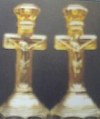Dugan/Diamond Peach Opal - Part 1
Dugan/Diamond Peach Opal - Part 1
*DUGAN / DIAMOND CONNECTION - a thoughtful preface
by Cliff Hoblit
Preface: Cliff and Mary Hoblit were emminently active members of the carnival glass community in both Northern and Southern California for many years. Although they lived in Arizona following retirement, they remained a vital part of the San Diego Carnival Glass Club. In June of 1996, based upon his research into the Dugan/Diamond history, along with the fact that he had originally come from the sector of the United States where Glass industry was part of everyday life for many of us, he compiled this fine article for the San Diego Club Newsletter, details of which were provided within an old book in his possession. We reprint it here in its entirety. As compared with other recorded accounts, this information bears some serious consideration . Knowledge is only as accurate as written accounts present it. This one bears some thought.
The Indiana Glass Works started Nov. 14, 1892. They went into production with 10 huge iron kettles. From that day on the plant had a great benefit to the local people and to glass collectors in general. The profits of the Company were very low. It was not long before the Company closed. In 1894, the Indiana Glass Works was assumed by different partners and about 1896 was renamed The Northwood Company. It operated under Harry's auspices till 1899. At that time, it became part of National Glass Corp. About Jan., 1904, it was sold to Thomas E.H. Dugan. He continued to make glass till May of 1913. He resigned and then was employed by Duncan-Miller for a short time. July 1913, the plant was renamed Diamond Glass Co., started to make more iridescent glass and opalescent glass advertised in “China, Glass & Lamps”-1913. Then in 1914 or 1915 was renamed Diamond Glassware Co. In 1931 the plant burned down, and was not rebuilt. (By 1914, Dugan formed Dugan Glass Company in Lonaconing, Maryland. Advertised once in “China, Glass & Lamps”- specializing in pressed tableware. Shortly after, they went to blown glass. This operation continued until 1932, when destroyed by fire.)
Based on the above facts, I believe that Dugan had very little to do with the manufacturing of Peach Opal, as it was made in 1914-1915; also because of the quantity of glass made. Dugan operated with 100-200 employees and operated about 8 years. Diamond operated 16 years. Dugan rarely operated a full year, as business was very slow during this time and he only ran one shift. After Diamond took over, the war in Europe was starting and the glass was in great demand. They operated the plant three shifts with nearly 800 employees.
These are the items that were advertised as being made by Dugan: Lampshades, sewing lamps, lantern globes, cream pitchers, soda glasses, tumblers, goblets, wine glasses, salt & peppers, bottles and molasses jugs.
Additional Note: Since no individual has all the answers to any question, we ask you to merge Cliff's statement into what has already been made public on the subject, and categorize it as you see fit. As some television detective in the 1960s used to say, “we only want the facts, boys; just the facts!” We, on the 101 are here to do just that-------from as many angles as they can be garnered from!
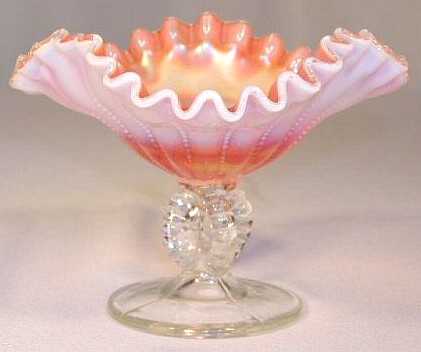
BEADED PANELS: Since this compote has been reproduced in non-iridized opalescent colors of blue and vaseline, the possibility of finding some which have been iridized exists. The reproductions have a solid fill of glass inside the four curved, beaded columns which make up the stem. The OLD examples are found in marigold, amethyst, cobalt blue, as well as peach opal. All of these have open spaces within the beaded columns on the stem. This is a unique stem among carnival glass compotes. The mold dates back to the early 1900s when Dugan made opalescent colored glass. Edge shapings are varied, from the tight crimp to a jack-in-the-pulpit type. Peach opal examples are not too difficult to locate, with marigold being much more challenging. Amethyst examples require a search, making that color rare. Cobalt blue compotes are considered rare indeed.
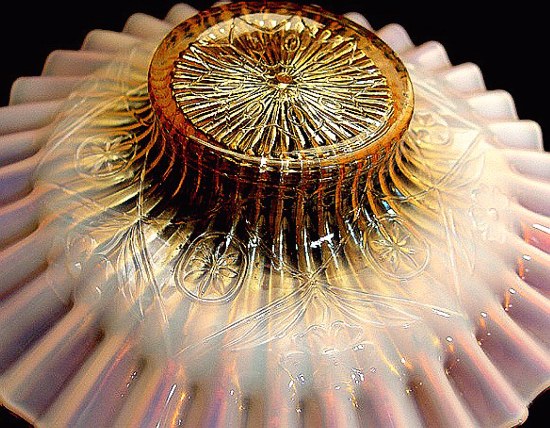
Exterior design - CAROLINE
CAROLINE: Examples of this exterior pattern began appearing in the Butler Bros. Wholesale Catalogs in 1910. Production was primarily for peach opalescent in the shapes of a banana bowl, 8”-9” bowls, a handled basket and a handgrip plate. Pattern is on the exterior and very difficult to photograph with any clarity. All shapes mentioned were fashioned from the basic 8”-9” bowl mold. Banana bowls are scarce. In rare instances, some bowls are found to have decorated enamel designs on the surface. These were regularly offered in the wholesale catalogs. Some handgrip plates are known to carry the painted designs on the interior, as well. Marigold bowls can be found.
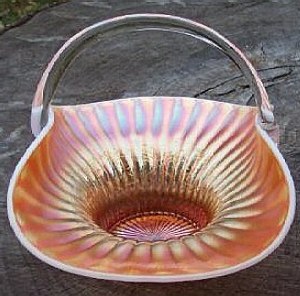 |
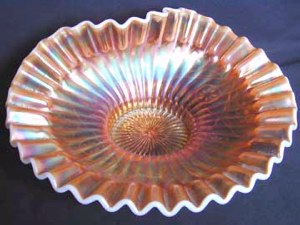 |
CAROLINE Basket-8 and one-half in. long x 6 in. wide and 6 and three-fourths in. to top of handle
|
CAROLINE Bowl Interior is
SMOOTH RAYS Pattern
|
CAROLINE Handled BASKET: Is a highly treasured item. The clear glass, separately applied handle creates an elegance to the otherwise banana shaped bowl. These were in the regular production line and should not be considered in the whimsy category. One known example of lavender opalescent basket has been confirmed. This is an extremely unusual color for Dugan.
SMOOTH RAYS Interior of Caroline: This design is somehow complimentary to the delicate Caroline design of the exterior. Simple, yet effective accent offered by this pattern, created extended use with several other commendable patterns.
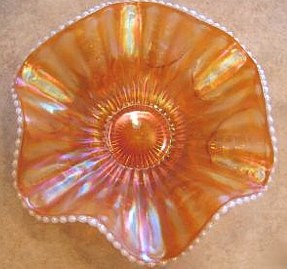 |
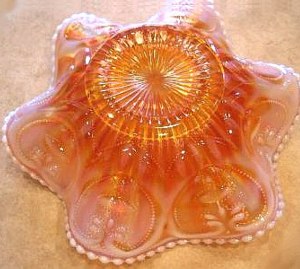 |
SMOOTH RAYS interior
|
JEWELLED HEART exterior of SMOOTH RAYS AND PETAL & FAN
|
SMOOTH RAYS: as it appears in use with Jewelled Heart Exterior pattern, which offers the beaded edge.
JEWELED HEART Exterior: Jan. 1905 this original pattern name, being Victor, came onto the scene in a non-iridescent blue, green, and flint opalescent, along with a gold decorated color called Apple Green. The Dugan D-in-a-diamond trademark has been found on some blue opal pieces. A very early Thomas Dugan design, with limited production in carnival examples, a 1910 Butler Bros. wholesale catalog ad displays the pattern in peach opal. Jeweled Heart pattern used as a primary pattern is found only on marigold pitchers and marigold and white tumblers, with both shapes to be considered quite rare. Exterior application of Jeweled Heart for use on a ruffled berry set, having Smooth Rays interior in marigold, amethyst, white, and peach opal, along with 6”-7” plates having the same Smooth Rays interior, and usually a very tightly crimped edge; as well as a small whimsey basket fashioned from the mold of the small berry bowl in peach opal, comprise the shape/color spectrum. The basket handle is of separately applied clear glass, such as seen on the Caroline and Ski Star baskets. The Farmyard bowl, Dugan's Cherry, and Petal & Fan bowls carry Jeweled Heart exterior.
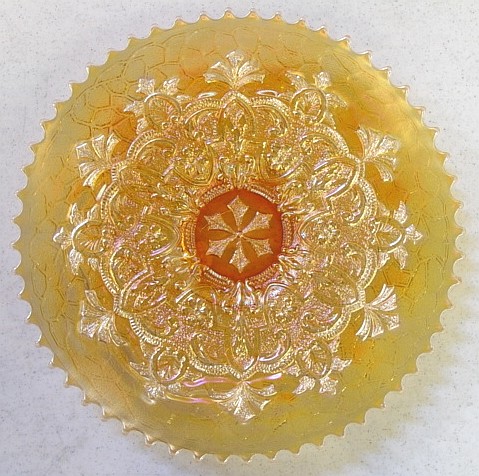
GARDEN PATH VT. Chop Plate in Peach Opal. One of three known!
GARDEN PATH Variant Chop Plate: There may be as many as three of these 11” chop plates in peach opal, flattened from the 10” ice cream-shaped bowl. About that same number in marigold are known. The opal is slight and only visible along the outer edge of the plate. Soda Gold (Tree of Life) is the exterior pattern usually found on these plates. Along with the 6” plates, these may have been marketed as “cake sets”. Few of the amethyst chop plates are available, but many of them are spectacular in appearance and iridescence. The example shown here was in the collection of Bernie and Nancy May, Maryland, and sold by Wroda Auctions during the Sunshine State Carnival Convention in FL-Jan. 2005. The sale price was $1900.
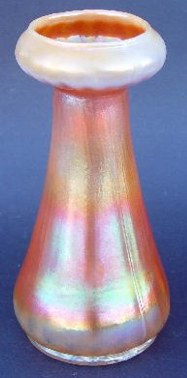 |
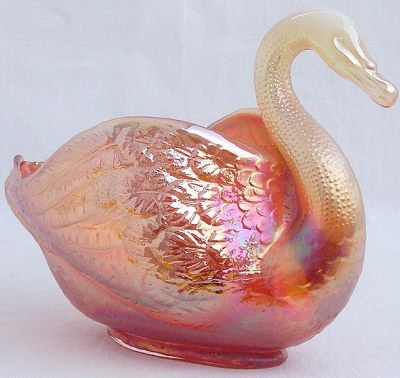 |
HYACINTH Vase
|
SWAN with ideally opalized neck and head!
|
HYACINTH vase: Found only in peach opalescent, these vases very likely were among Thomas Dugan's earliest carnival glass offerings. The Dugan name for this color was “Pearl Iris”. The shape of this vase appears in several Butler Brother assortments of Dugan's Venetian art glass, dating to 1909, then was moved into carnival glass production at the beginning of the era. Only a handful of these vases are known today.
SWAN: in peach opal remains the least available variety, and will command respectable prices these days! The Dugan/Diamond version is recognizable with its stippled neck area. Dugan created the early examples in clear glass having an opal' edge. Opal' is a word used by Frank M. Fenton for describing the milk-effect edge. Dugan also made a pretty green opalescent swan during that 1906 timeframe. These were non-iridescent versions.
Alan and Lorraine Pickup have written extensively about their collection of some 30 of these various swans, saying that one of the opal' examples has the Dugan/Diamond “D” trademark on the underside.
Fenton and Imperial each made Swans. Fenton has used several different moulds for their iridescent models, and continue to produce them today in at least two different mould designs. They began signing them in the 1970s.
Old Imperial Swans were not made in iridescent colors, and like Fenton, reproduced the Swans before going out of business. The newer Swans' iridescence simply does not have the vintage appearance. The head detail is different and they are usually signed I/G or LI/G.
Dugan/Diamond Swans in marigold, celeste blue, amethyst and peach opal apparently came along later than the opalescent versions. Carl Burns' Dugan/Diamond Carnival Glass book places the peach opal and amethyst as Dugan produced, circa 1909-1910, and the marigold Swan as being made later, under the Diamond Glass Co. about 1914, followed by celeste blue in 1916. With exception of the celeste blue, the other three carnival glass colors can be considered scarce to rare today.
Moulds are worn and past their prime. Results can readily be seen in the many crude carnival glass Swans made since the 1970s. Extra glass ridges, resulting in splits in the mould are commonplace.
Pickup's belief is that a new Swan mould was ready about the time of the disastrous fire. Did Fenton Glass purchase the new mould, along with many other items in the “after the fire” sale? Is this the mould referred to as the Northwood mould? We can find no reason to believe that Northwood ever made any Swans! “We have a couple of Swans purchased at the Fenton outlet store made from that very mould. This is all just our opinion today. Due to a lack of exact record keeping when this glass was in its heyday, this is only conjecture on our part.”
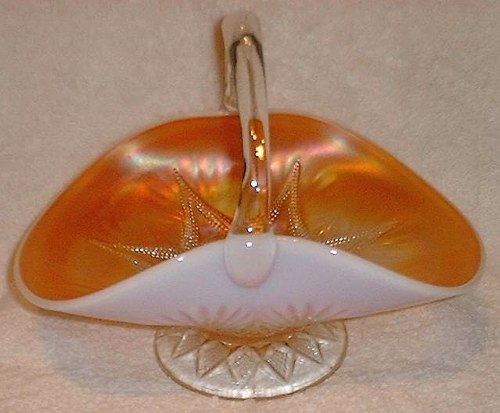
SKI STAR - COMPASS large handled basket (peach opal)
SKI STAR Handled BASKET: Rarely available in either of two sizes known, we hasten to add that long-time collector, Larry Keig, Iowa, recently provided a photo of this lovely example, conveying a great deal of pride in finally having the ability to purchase one, following many years of search! We are happy to share it with our viewers.
The larger basket was fashioned from the dome-footed banana bowl shape, having the clear applied handle extending between the two pulled-up sides. The smaller basket was made from the 6” ruffled bowl and also has the clear glass applied handle. It is extremely rare, with only a couple of examples confirmed. It should be considered a whimsey. The larger basket was a regular production item, appearing in several Butler Brothers wholesale catalogs. Each of the baskets are found only in peach opalescent.
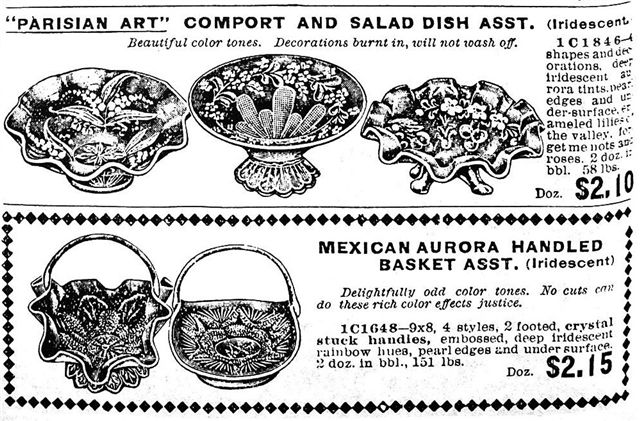
SANTA CLAUS Edition of Butler Bros. Catalog - 1910
Santa Claus Editon 1910-Butler Bros. Wholesale Catalog: displays three variations of the factory applied enameled painting:
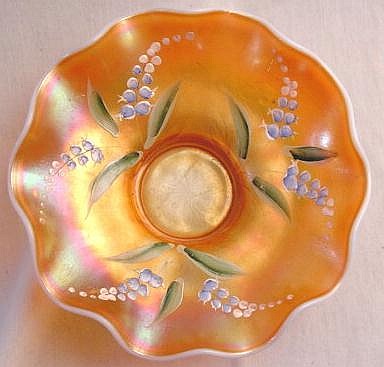
LILY of the VALLEY - Factory applied hand-painting on what is likely an 8.50 inch
SINGLE FLOWER ruffled bowl. (Exterior pattern.)
LILY of the VALLEY: is but one of the factory applied-hand-painted designs which appear on Caroline, Stippled Petals, Stippled Flower, Footed Cherries, Single Flower, and Dogwood Sprays, and possibly others. This hand-enameled work seems always to be found on peach opal examples, but the possibility of it appearing on other colors may exist.
Dean & Diane Fry - 5/05
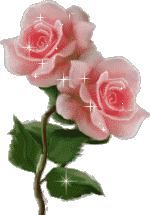
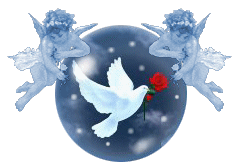

“The effective, fervent prayer of a righteous man avails much” (James 5:16). Prayer has power. We are to “continue earnestly in prayer, being vigilant” (Colossians 4:2). How are your knees?............When I kneel before my Master,
I can feel His presence there,
And the load of care and sorrow
Seems much easier to bear.-Anon.
~~~~~ Prayer does not require eloquence but earnestness.

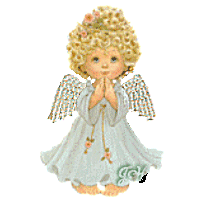
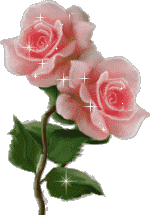
Should you care to contact the Frys, their email address is:
Search Our Sites
back to Carnival Glass 101
Our other sites you may enjoy:
Everything you EVER wanted to know about Indiana Glass
Great Reference for Newer Carnival Glass.
Complete Glassware Catalogs Available to Download
Questions? Comments? Suggestions? Broken Links? Corrections?
Your Friendly Webmaster is here to help!
